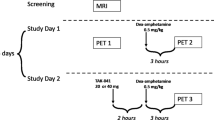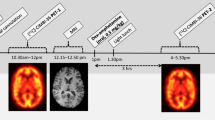Abstract
The effect of endogenous dopamine (DA) on neostriatal DA D1 and D2 receptor binding potentials (D1RBP and D2RBP, respectively) in vivo was evaluated with positron emission tomography (PET) and the radiotracers [11C]SCH23390 and [11C]raclopride, respectively, by comparing the D1RBP and D2RBP before and after acute DA depletion. DA depletion was achieved by per-oral administration of 4500 mg α-methyl-para-tyrosine (AMPT) given in the 25 h prior to [11C]SCH23390 PET and of 5250 mg AMPT given in the 29 h prior to [11C]raclopride PET. Six healthy subjects completed the protocol. The AMPT treatment decreased plasma levels of the DA metabolite homovanillic acid by 61 ± 16% (4500 mg; average ± standard deviation) and 62 ± 17% (5250 mg), and levels of the norepinephrine metabolite 3-methoxy-4-hydroxyphenethyleneglycol by 58 ± 7% (4500 mg) and 66 ± 5% (5250 mg). This AMPT treatment increased D2RBP significantly from 3.18 ± 0.34 to 3.59 ± 0.30 but no significant change was observed in D1RBP (1.64 ± 0.24 pre AMPT vs 1.70 ± 0.17 post AMPT). Thus, while DA depletion ‘uncovers’ D2receptors, it does not do so for D1 receptors. The implications of this finding for measuring endogenous DA and its effects on in vivo receptor binding in humans are discussed.
This is a preview of subscription content, access via your institution
Access options
Subscribe to this journal
Receive 12 print issues and online access
$259.00 per year
only $21.58 per issue
Buy this article
- Purchase on Springer Link
- Instant access to full article PDF
Prices may be subject to local taxes which are calculated during checkout


Similar content being viewed by others
References
Laruelle M, D'Souza CD, Baldwin RM, Abi-Dargham A, Kanes SJ, Fingado CL et al. Imaging D2 receptor occupancy by endogenous dopamine in humans Neuropsychopharmacology 1997 17: 162–174
Abi-Dargham A, Rodenhiser J, Printz D, Zea-Ponce Y, Gil R, Kegeles LS et al. Increased baseline occupancy of D2 receptors by dopamine in schizophrenia Proc Natl Acad Sci USA 2000 97: 8104–8109
Verhoeff NPLG, Kapur S, Hussey D, Lee M, Christensen B, Papatheodorou G, Zipursky RB . A simple method to measure baseline occupancy of neostriatal dopamine D2 receptors by dopamine in vivo in healthy subjects Neuropsychopharmacology 2001 25: 213–223
Okubo Y, Suhara T, Suzuki K, Kobayashi K, Inoue O, Terasaki O et al. Decreased prefrontal dopamine D1 receptors in schizophrenia revealed by PET Nature 1997 385: 634–636
Abi-Dargham A, Gill R, Mawlawi O, Hwang DR, Martinez D, Kochan L et al. Selective upregulation of prefrontal D1 receptors in schizophrenia predicts poor working memory performance J Nucl Med 2001 42 (Suppl): 17P (Abstract)
Suhara T, Nakayama K, Inoue O, Fukuda H, Shimizu M, Mori A, Tateno Y . D1 dopamine receptor binding in mood disorders measured by positron emission tomography Psychopharmacology (Berl) 1992 106: 14–18
Shinotoh H, Inoue O, Hirayama K, Aotsuka A, Asahina M, Suhara T et al. Dopamine D1 receptors in Parkinson's disease and striatonigral degeneration: a positron emission tomography study J Neurol Neurosurg Psychiatry 1993 56: 467–472
Turjanski N, Lees AJ, Brooks DJ . In vivo studies on striatal dopamine D1 and D2 site binding in L-DOPA-treated Parkinson's disease patients with and without dyskinesias Neurology 1997 49: 717–723
Brooks DJ, Piccini P, Turjanski N, Samuel M . Neuroimaging of dyskinesia Ann Neurol 2000 47 (Suppl 1): S154–S159
Sedvall G, Karlsson P, Lundin A, Anvret M, Suhara T, Halldin C, Farde L . Dopamine D1 receptor number—a sensitive PET marker for early brain degeneration in Huntington's disease Eur Arch Psychiatry Clin Neurosci 1994 243: 249–255
Turjanski N, Weeks R, Dolan R, Harding AE, Brooks DJ . Striatal D1 and D2 receptor binding in patients with Huntington's disease and other choreas. A PET study Brain 1995 118: 689–696
Backman L, Robins-Wahlin TG, Lundin A, Ginovart N, Farde L . Cognitive deficits in Huntington's disease are predicted by dopaminergic PET markers and brain volumes Brain 1997 120: 2207–2217
Ginovart N, Lundin A, Farde L, Halldin C, Backman L, Swahn CG et al. PET study of the pre- and post-synaptic dopaminergic markers for the neurodegenerative process in Huntington's disease Brain 1997 120: 503–514
Lawrence AD, Weeks RA, Brooks DJ, Andrews TC, Watkins LH, Harding AE et al. The relationship between striatal dopamine receptor binding and cognitive performance in Huntington's disease Brain 1998 121: 1343–1355
Rinne JO, Hublin C, Partinen M, Ruottinen H, Negren K, Lehikoinen P et al. Striatal dopamine D1 receptors in narcolepsy: a PET study with [11C]NNC 756 J Sleep Res 1996 5: 262–264
Inoue O, Tsukada H, Yonezawa H, Suhara T, Langstrom B . Reserpine-induced reduction of in vivo binding of SCH23390 and N-methylspiperone and its reversal by d-amphetamine Eur J Pharmacol 1991 197: 143–149
Inoue O, Kobayashi K, Sakiyama Y, Suzuki T . The effect of benzodiazepines on the binding of [3H]SCH23390 in vivo Neuropharmacology 1992 31: 115–121
Guo N, Waterhouse RN, Hwang DR, Zea-Ponce Y, Huang Y, Simpson N et al. Effect of endogenous dopamine on in vivo binding of dopamine D1 and D2 radiotracers NeuroImage 2000 11: S4 (Abstract)
Dumartin B, Caille I, Gonon F, Bloch B . Internalization of D1 dopamine receptor in striatal neurons in vivo as evidence of activation by dopamine agonists J Neurosci 1998 18: 1650–1661
Laruelle M . Imaging synaptic neurotransmission with in vivo binding competition techniques: a critical review J Cereb Blood Flow Metab 2000 20: 423–451
Laruelle M, Huang Y . Vulnerability of positron emission tomography radiotracers to endogenous competition. New insights Q J Nucl Med 2001 45: 124–138
Fujita M, Verhoeff NPLG, Varrone A, Zoghbi SS, Baldwin RM, Jatlow PA et al. Imaging extrastriatal dopamine D2 receptor occupancy by endogenous dopamine in healthy humans Eur J Pharmacol 2000 387: 179–188
Machin D, Campbell MJ . Statistical Tables for the Design of Clinical Trials Blackwell Scientific Publications: Oxford, UK 1987
Chan GL, Holden JE, Stoessl AJ, Doudet DJ, Wang Y, Dobko T et al. Reproducibility of the distribution of carbon-11-SCH 23390, a dopamine D1 receptor tracer, in normal subjects J Nucl Med 1998 39: 792–797
Anand A, Darnell A, Miller HL, Berman RM, Cappiello A, Oren DA et al. Effect of catecholamine depletion on lithium-induced long-term remission of bipolar disorder Biol Psychiatry 1999 45: 972–978
Kegeles LS, Mawlawi O, Rodenhiser J, Martinez D, Broft A, Fullerton C et al. Measurement of D2 receptor occupancy by dopamine in human ventral and dorsal striatum J Nucl Med 2001 42 (Suppl): 16P (Abstract)
Thibaut F, Vaugeois LM, Bonnet JJ, Costentin J . In vivo striatal binding of the D1 antagonist SCH 23390 is not modified by changes in dopaminergic transmission Neuropharmacology 1996 35: 267–272
Abi-Dargham A, Simpson N, Kegeles L, Parsey R, Hwang DR, Anjilvel S et al. PET studies of binding competition between endogenous dopamine and the D1 radiotracer [11C]NNC 756 Synapse 1999 32: 93–109
Barbier P, Colelli A, Maggio R, Bravi D, Corsini GU . Pergolide binds tightly to dopamine D2 short receptors and induces receptor sequestration J Neural Transm 1997 104: 867–874
Ito K, Haga T, Lameh J, Sadee W . Sequestration of dopamine D2 receptors depends on coexpression of G-protein-coupled receptor kinases 2 or 5 Eur J Biochem 1999 260: 112–119
Guo N, Huang Y, Zea-Ponce Y, Hwang DR, Zhu ZH, Laruelle M . Effect of dopamine depletion on in vivo binding of 11CFLB 457 and 123Iepidepride to striatal and extrastriatal D2 receptors in rodents J Nucl Med 2001 42: 213P (Abstract)
Engelman K, Jequier E, Udenfriend S, Sjoerdsma A . Metabolism of alpha-methyltyrosine in man: relationship to its potency as an inhibitor of catecholamine biosynthesis J Clin Invest 1968 47: 568–576
Warsh JJ, Godse DD, Li PP . Quantitation of catecholamine metabolites by gas chromatography-mass spectrometry with selected ion monitoring Meth Enzymol 1987 142: 571–582
Takahashi S, Godse DD, Warsh JJ, Stancer HC . A gas chromatographic-mass spectrometric (GC-MS) assay for 3-methoxy-4-hydroxyphenylethyleneglycol and vanylmandelic acid in human serum Clin Chim Acta 1977 81: 183–192
Roy SD, McKay G, Hawes EM, Midha KK . Gas chromatographic quantitation of methoxyamphetamine and three of its metabolites in plasma J Chromatogr 1984 310: 307–317
Abbott Laboratories. Imx® Prolactin Abbott Park: Illinois 1997 pp 1–11
Wang GJ, Volkow ND, Levy AV, Fowler JS, Logan J, Alexoff D et al. MRI-PET image coregistration for quantification of striatal dopamine D2 receptors J Comput Assist Tomogr 1996 20: 423–428
Lammertsma AA, Hume SP . Simplified reference tissue model for PET receptor studies NeuroImage 1996 4: 153–158
Lammertsma AA, Bench CJ, Hume SP, Osman S, Gunn K, Brooks DJ, Frackowiak RSJ . Comparison of methods for analysis of clinical [11C]raclopride studies J Cereb Blood Flow Metab 1996 16: 42–52
Ito H, Hietala J, Blomqvist G, Halldin C, Farde L . Comparison of the transient equilibrium and continuous infusion method for quantitative PET analysis of [11C]raclopride binding J Cereb Blood Flow Metab 1998 18: 941–950
Gunn RN, Lammertsma AA, Hume SP, Cunningham VJ . Parametric imaging of ligand-receptor binding in PET using a simplified reference tissue model NeuroImage 1997 6: 279–287
Mikolajczyk K, Szabatin M, Rudnicki P, Grodzki M, Burger C . A JAVA environment for medical image data analysis: initial application for brain PET quantitation Med Inf 1998 23: 207–214
Martres MP, Bouthenet ML, Sales N, Sokoloff P, Schwartz JC . Widespread distribution of brain dopamine receptors evidenced with [125I]iodosulpride, a highly selective ligand Science 1985 228: 752–755
Tabachnick BG, Fidell LS . Using Multivariate Statistics, 3rd edn Harper Collins College Publishers: California State University, Northridge, CA 1996 pp 57–126
Acknowledgements
This work was supported by a Young Investigator Award from the National Alliance for Research on Schizophrenia and Affective Disorders to Dr Verhoeff, by a Postdoctoral Research Fellowship Award from the Ontario Mental Health Foundation to Dr Verhoeff, and by a grant from the Canadian Institute for Health Research to Dr Kapur. The authors gratefully acknowledge Merck & Co, West Point, Pennsylvania, USA, and Merck Frosst Canada, Point-Claire, Dorval, Quebec, Canada, for providing the AMPT; Cyrill Burger, PET Center, Division of Nuclear Medicine, University Hospital, Zürich, Switzerland, for providing the JAVA-based dedicated software PMOD; Terry Bell and Kevin Cheung for assistance in PET data acquisition; Corey Jones for his assistance with the preparation of the two figures; and staff of the Clinical Investigation Unit, 10th floor, Clarke Division, Centre for Addiction and Mental Health, for support for and management of the subjects during their overnight stay in the psychiatric inpatient unit.
Author information
Authors and Affiliations
Corresponding author
Rights and permissions
About this article
Cite this article
Verhoeff, N., Hussey, D., Lee, M. et al. Dopamine depletion results in increased neostriatal D2, but not D1, receptor binding in humans. Mol Psychiatry 7, 322–328 (2002). https://doi.org/10.1038/sj.mp.4001057
Received:
Revised:
Accepted:
Published:
Issue Date:
DOI: https://doi.org/10.1038/sj.mp.4001057
Keywords
This article is cited by
-
Estimating Endogenous Dopamine Levels at D2 and D3 Receptors in Humans using the Agonist Radiotracer [11C]-(+)-PHNO
Neuropsychopharmacology (2014)
-
Disrupted Dopaminergic Neurotransmission in 22q11 Deletion Syndrome
Neuropsychopharmacology (2008)
-
AMPT-induced monoamine depletion in humans: evaluation of two alternative [123I]IBZM SPECT procedures
European Journal of Nuclear Medicine and Molecular Imaging (2008)
-
Monoamine depletion in psychiatric and healthy populations: review
Molecular Psychiatry (2003)
-
Dopamine Depletion and In Vivo Binding of PET D1 Receptor Radioligands: Implications for Imaging Studies in Schizophrenia
Neuropsychopharmacology (2003)



